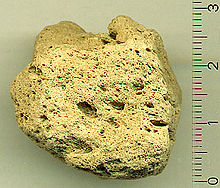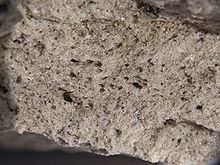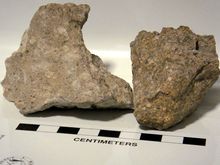This is an old revision of this page, as edited by 158.104.170.155 (talk) at 03:09, 20 September 2011. The present address (URL) is a permanent link to this revision, which may differ significantly from the current revision.
Revision as of 03:09, 20 September 2011 by 158.104.170.155 (talk)(diff) ← Previous revision | Latest revision (diff) | Newer revision → (diff)
Pumice /ˈpʌms/ is a textural term for a volcanic rock that is a solidified frothy lava typically created when super-heated, highly pressurized rock is violently ejected from a volcano. It can be formed when lava and water are mixed. This unusual formation is due to the simultaneous actions of rapid cooling and rapid depressurization. The depressurization creates bubbles by lowering the solubility of gases (including water and CO2) dissolved in the lava, causing the gases to rapidly exsolve (like the bubbles of CO2 that appear when a carbonated drink is opened). The simultaneous cooling and depressurization freezes the bubbles in the matrix.
Properties



Pumice is composed of highly microvesicular glass pyroclastic with very thin, translucent bubble walls of extrusive igneous rock. It is commonly, but not exclusively of silicic or felsic to intermediate in composition (e.g., rhyolitic, dacitic, andesite, pantellerite, phonolite, trachyte), but basaltic and other compositions are known. Pumice is commonly pale in color, ranging from white, cream, blue or grey, to green-brown or black. It forms when volcanic gases exsolving from viscous magma nucleate bubbles which cannot readily decouple from the viscous magma prior to chilling to glass. Pumice is a common product of explosive eruptions (plinian and ignimbrite-forming) and commonly forms zones in upper parts of silicic lavas. Pumice has an average porosity of 90%, and initially floats on water.
Scoria differs from pumice in being denser. With larger vesicles and thicker vesicle walls, it sinks rapidly. The difference is the result of the lower viscosity of the magma that forms scoria. When larger amounts of gas are present, the result is a finer-grained variety of pumice known as pumicite. Pumice is considered a glass because it has no crystal structure. Pumice varies in density according to the thickness of the solid material between the bubbles; many samples float in water. After the explosion of Krakatoa, rafts of pumice drifted through the Pacific Ocean for up to 20 years, with tree trunks floating among them. In fact, pumice rafts disperse and support several marine species. In 1979, 1984 and 2006, underwater volcanic eruptions near Tonga created large pumice rafts, some as large as 30 kilometres that floated hundreds of kilometres to Fiji.
There are two main forms of vesicles. Most pumice contains tubular microvesicles that can impart a silky or fibrous fabric. The elongation of the microvesicles occurs due to ductile elongation in the volcanic conduit or, in the case of pumiceous lavas, during flow. The other form of vesicles are subspherical to spherical and result from high vapor pressure during eruption.
Uses
Pumice is widely used to make lightweight concrete or insulative low-density breeze blocks. When used as an additive for cement, a fine-grained version of pumice called pozzolan is mixed with lime to form a light-weight, smooth, plaster-like concrete. This form of concrete was used as far back as Roman times. Roman engineers used it to build the huge dome of the Pantheon and as construction material for many aqueducts.
It is also used as an abrasive, especially in polishes, pencil erasers, cosmetic exfoliants, and the production of stone-washed jeans. "Pumice stones" are often used in beauty salons during the pedicure process to remove dry and excess skin from the bottom of the foot as well as calluses. It was also used in ancient Greek and Roman times to remove excess hair. Finely ground pumice is added to some toothpastes and heavy-duty hand cleaners (such as Lava soap) as a mild abrasive. Pumice is also used as a growing substrate for growing horticultural crops.
References
- De Vantier, L.M. (1992). "Rafting of tropical marine organisms on buoyant coralla" (PDF). Marine Ecology Progress Series. 86: 301–302. doi:10.3354/meps086301. Retrieved 2007-07-14.
Trunks and pumice that washed ashore at Keeling Atoll in the early 1900's had been drifting for some 20 years, since the eruption of Krakatoa 1000 km to the northeast in 1883 (Wood-Jones 1912)
{{cite journal}}: Cite has empty unknown parameter:|coauthors=(help); Unknown parameter|month=ignored (help) - Bryan, S.E. (2004). "Pumice rafting and faunal dispersion during 2001–2002 in the Southwest Pacific: record of a dacitic submarine explosive eruption from Tonga" (PDF). Earth and Planetary Science Letters. 227: 135–154. Bibcode:2004E&PSL.227..135B. doi:10.1016/j.epsl.2004.08.009. Retrieved 2007-07-14.
The abundance and variety of fouling taxa, coupled with the long dispersal trajectory (> 3500 km) and period of pumice floatation (≥ 1 year), confirm the importance of sea-rafted pumice as a long-distance dispersal mechanism for marine organisms
{{cite journal}}: Cite has empty unknown parameter:|month=(help); Unknown parameter|coauthors=ignored (|author=suggested) (help) - "New Island and pumice raft in the Tongas". NASA Earth Observatory. National Aeronautics and Space Administration. 16 November 2006.
- Sherrow, V. 2001. For appearance' sake: the historical encyclopedia of good looks. Greenwood, 312pp. ISBN 1-57356-204-1
External links
- University of Oxford image of pumice. Retrieved 2010-09-27.
- Analytical identification of a single source pumice from Greek shores and ancient sites in the Levant.
- On the occurrence of a pumice-rich layer in Holocene deposits of western Peloponnesus, Ionian Sea, Greece. A geomorphological and geochemical approach.